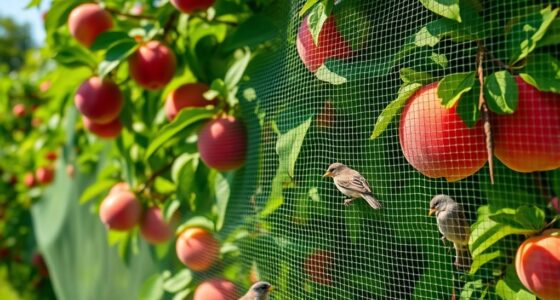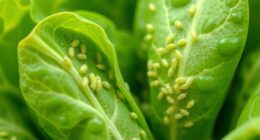Fruit russeting shows as a rough, brownish coating on the skin and is mainly caused by insect damage and weather stress. Pests like codling moths or apple maggots create injuries that trigger the fruit’s protective response, leading to russeting. Meanwhile, temperature fluctuations, rain, and sunlight cause skin stress and cracking, making russeting more likely. Managing pests and minimizing weather stress can reduce russeting, and you’ll discover more ways to prevent it as you continue exploring this topic.
Key Takeaways
- Insect damage from pests like codling moths creates skin injuries that trigger russeting as a protective response.
- Environmental stressors such as temperature fluctuations and sudden cold snaps cause skin cracking and russet development.
- High humidity and extended rain weaken fruit skin and promote fungal growth, increasing russeting risk.
- Sun exposure leads to uneven warming and localized stress, resulting in russeted patches on fruit surfaces.
- Managing pests and stabilizing orchard microclimate helps reduce injury and weather-related russeting.

Have you ever noticed a rough, brownish coating on the surface of certain fruits? That’s fruit russeting, a common condition that affects apples, pears, and other fruits. While it might look unsightly, russeting isn’t usually harmful to the fruit’s edibility. However, it can influence the fruit’s appearance, market value, and sometimes its texture. Understanding what causes russeting helps you prevent or manage it effectively, especially when considering pest management and the weather impact.
Russeting occurs when the fruit’s natural surface develops a rough, leathery layer. This isn’t simply a cosmetic issue; it results from the fruit’s response to environmental and biological factors. One key element is pest management. Certain insects, like codling moths or apple maggots, can indirectly contribute to russeting by damaging the fruit’s skin or creating entry points for pathogens. These injuries stress the fruit, prompting it to produce extra protective layers, which may manifest as russeting. Managing pests effectively reduces the likelihood of skin injuries, thereby minimizing russet development. Using appropriate insecticides, monitoring pest populations, and employing integrated pest management strategies help keep these pests at bay and lessen their impact on the fruit’s surface.
Pest management reduces skin injuries that lead to russeting, maintaining fruit appearance and health.
Weather impact plays a notably role in russeting as well. Fluctuations in temperature, humidity, and moisture levels directly influence the formation of russeting. For instance, sudden drops in temperature after the fruit has set can cause the skin to crack or become stressed, leading to russet formation. Similarly, prolonged periods of high humidity or excessive rain can create conditions that promote russeting by weakening the fruit’s skin or encouraging fungal growth. Additionally, exposure to direct sunlight can cause uneven heating, resulting in localized skin stress and subsequent russeting. To mitigate weather impact, growers often use protective coverings or modify irrigation practices to stabilize the microclimate around the fruit. Proper orchard management, including choosing resistant varieties and timing harvests carefully, can also help reduce weather-related russeting.
Another aspect to consider is the influence of fruit varieties that are more susceptible to russeting, which can guide growers in selecting appropriate cultivars for their climate. In essence, russeting is a complex interplay of biological and environmental factors. Effective pest management reduces physical injuries that can trigger russeting, while understanding weather impact allows you to adapt your practices to minimize stress on the fruit. By paying close attention to these factors, you can improve the overall quality and appearance of your harvest. Although russeting isn’t always entirely preventable, proactive measures tailored to pest control and weather conditions considerably decrease its occurrence, ensuring your fruits remain attractive and market-ready.
Frequently Asked Questions
Can Fruit Russeting Be Completely Prevented?
You can’t completely prevent fruit russeting, but you can reduce its occurrence. By selecting varieties with genetic resistance and implementing proper cultural practices, you improve your chances. Regularly manage weather exposure and handle fruits gently to minimize damage. While russeting might still happen, these steps help you control it effectively, making your fruit look better and reducing losses. Consistent effort makes a noticeable difference.
Are There Specific Fruit Varieties More Prone to Russeting?
You should know that certain fruit varieties are more prone to russeting due to genetic susceptibility and varietal characteristics. For example, apples like Cox’s Orange Pippin and Egremont Russet tend to develop russeting more easily. By choosing varieties with lower susceptibility, you can reduce russeting. Understanding these genetic and varietal traits helps you select fruits less prone to russeting, leading to better appearance and quality.
How Does Russeting Affect Fruit Flavor and Texture?
Russeting can dramatically change your fruit’s flavor and texture, making it seem almost unrecognizable! When the fruit skin develops russet, it often leads to a flavor alteration, sometimes making the fruit taste more earthy or bland. The texture can become rough or gritty, losing its smooth, juicy feel. This weather-induced russeting can turn a perfectly crisp apple into a dull, less appealing snack, frustrating your taste buds and expectations.
Is Russeting Linked to Specific Pests Besides Insects?
Russeting isn’t directly linked to pests other than insects. However, effective pest management and accurate insect identification help prevent russeting caused by insect damage, like from codling moths or aphids. By monitoring pests closely, you reduce the risk of skin damage that can lead to russeting. Staying vigilant and applying targeted treatments guarantees your fruit remains smooth and healthy, minimizing russeting linked to pest activity.
Can Environmental Changes Reduce Future Russeting Occurrences?
You can markedly reduce future russeting by implementing environmental mitigation and climate adaptation strategies. Studies show that adjusting orchard practices can cut russeting rates by up to 30%. By managing humidity, optimizing air flow, and selecting resilient varieties, you create a more stable environment that discourages russet development. These measures help you adapt to changing climates, protecting your fruit’s appearance and quality, and ensuring better yields in the long run.
Conclusion
Understanding the causes of fruit russeting reveals that both insects and weather are the artists behind this natural canvas. While it might seem like a flaw, it’s simply nature’s way of telling you that every fruit bears its own story, etched with the touch of its environment. Embrace these marks as part of the fruit’s journey, reminding you that beauty often lies in imperfections—proof that nature’s artistry is both unpredictable and uniquely beautiful.









